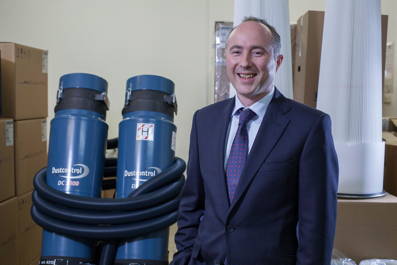 Cleanzine: your weekly cleaning and hygiene industry newsletter 18th April 2024 Issue no. 1110
Cleanzine: your weekly cleaning and hygiene industry newsletter 18th April 2024 Issue no. 1110
Your industry news - first
The original and best - for over 20 years!
We strongly recommend viewing Cleanzine full size in your web browser. Click our masthead above to visit our website version.
Dust - why it's an issue and what industries should be doing about it...
 Dust is a major problem across a wide range of industries. Despite the impact of dust, many workers in many industries don't seem to be aware of just how serious or how important the issue of dust really is.
Dust is a major problem across a wide range of industries. Despite the impact of dust, many workers in many industries don't seem to be aware of just how serious or how important the issue of dust really is.
Not only do they underestimate the seriousness of the issue, they fail to appreciate how tackling the problems caused by dust can both improve business turnover and provide a 'greener' way of working.
The negatives of industrial dust are many fold. It creates a dirty working environment, hinders production efficiency, lowers staff morale, affects product quality and provides a health and safety risk.
There are companies that do attempt to address the situation, but unless they've enlisted professional help, most of these are not being as effective or efficient as possible in their approach.
If you walk into industrial processing plants, in many cases you're likely to see an abundance of cheap mobile dust extractors. The fact that an attempt is being made to rectify dust-related issues is certainly a positive. But it's often the case that in large processing plants these can become more of a nuisance as opposed to providing any real assistance in resolving the matter.
The mobile dust extractors used in these instances are often fitted with low quality filtration and are poorly maintained, as personnel are unwilling to take responsibility for keeping them clean and ensuring that they're looked after. It's also more than likely that they constitute a health and safety risk, with leads and cables stretching across the production area. These not only pose the risk of tripping, but also make the area look untidy, which isn't ideal during a client factory tour.
There's also often a lack of understanding on just how these extractors should be used, with many companies opting to use them after processing rather than during. Mobile dust extractors might seem like an attractive short-term solution to workplace dust and the balance sheet, but they usually fail to achieve the desired results with running costs actually making them more detrimental in the longer term.
The best way for industrial plants to address the issue of dust is to install centralised vacuum systems. These can fit into the building in question, and have a number of plug-in points running off them, avoiding the need for messy leads running everywhere. The systems can run for 24 hours, and are even self-cleaning. Lease finance for this type of equipment is becoming a much more common way of avoiding large Capex sign off and helping to manage cash flow.
Central vacuum systems are also energy efficient. Depending on the number of open outlets, the RPM of the vacuum producer can be optimised generating just as much vacuum as needed. And when no outlets are open the vacuum automatically switches to a saving mode, thus reducing both carbon emissions and running costs.
What's more, a centralised vacuum system can help solve any 'product loss' issues - where what's coming out at the end of the production line is less than what's being put in at the start. The systems can show visibly what they've collected during the process, so if there are still serious 'product loss' issues these can be backed up with accurate data. Dust or product that it is removed during the extraction process can also be recycled where necessary.
The benefits of a centralised vacuum system are many. Working in a cleaner environment will not only improve staff morale, it will also reduce the risk of potential health issues for employees. Dust extraction at source improves air quality, helping to tackle occupational asthma and other such respiratory illnesses.
It's also important to bear in mind the fact that many dusts are combustible. When a material, such as foodstuffs, is suspended in the air in a finely divided form, in the right concentration and in the right conditions, explosions can occur. It's therefore imperative to reduce the risks posed in an environment where these materials are both in abundance and being processed in a way that causes dust to form. A centralised vacuum system is one of the key methods of doing so.
On a more business minded level, dust extraction will help to improve product quality as it removes dust from both the product and any associated packaging, whilst also reducing the need for maintenance, which allows valuable resources to be spent elsewhere.
This article was produced exclusively for Cleanzine, by James Miller, managing director at Dustcontrol UK.
T: 01327 858001
E: [email protected]
W: www.dustcontroluk.co.uk
12th June 2014







